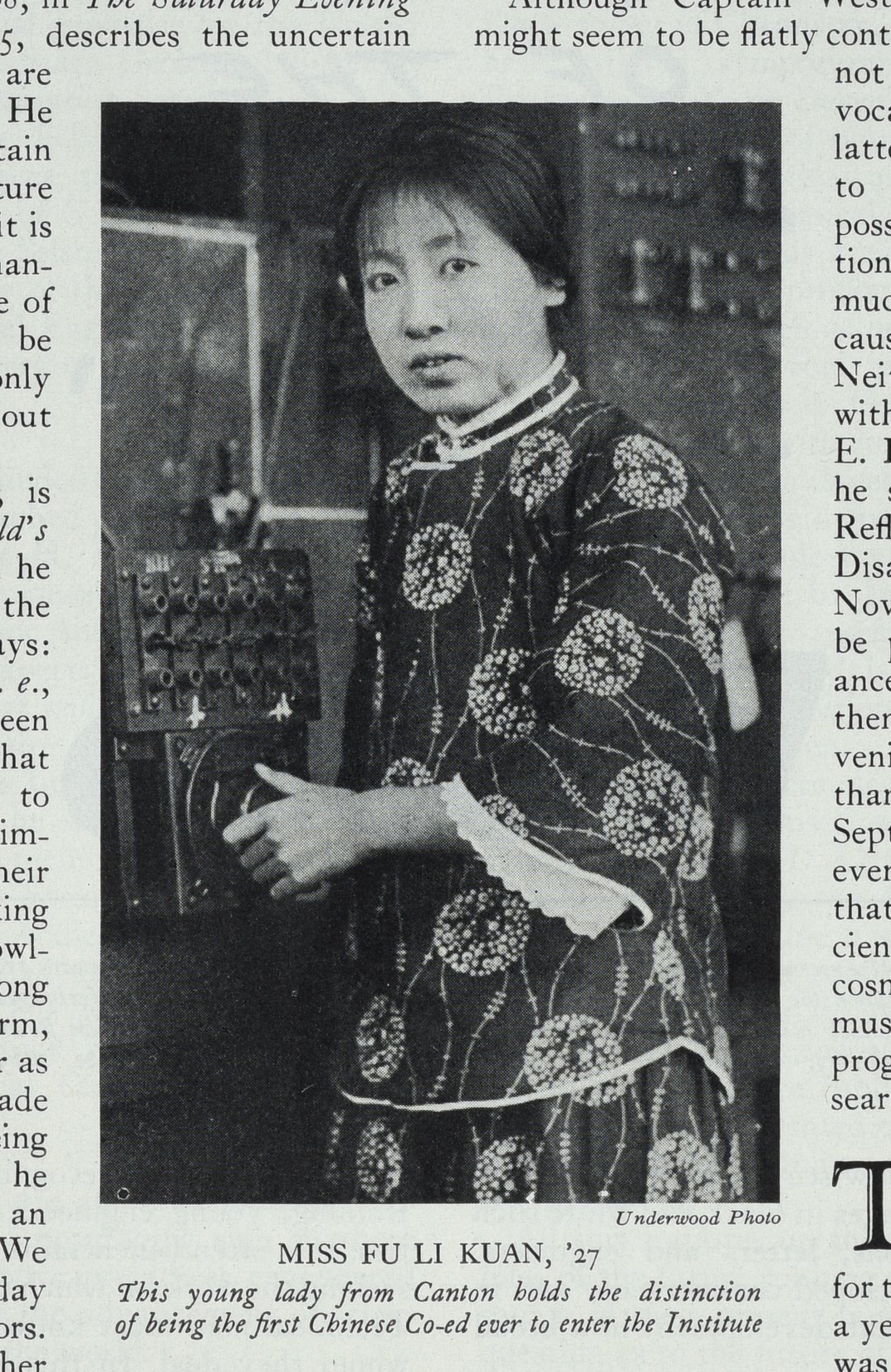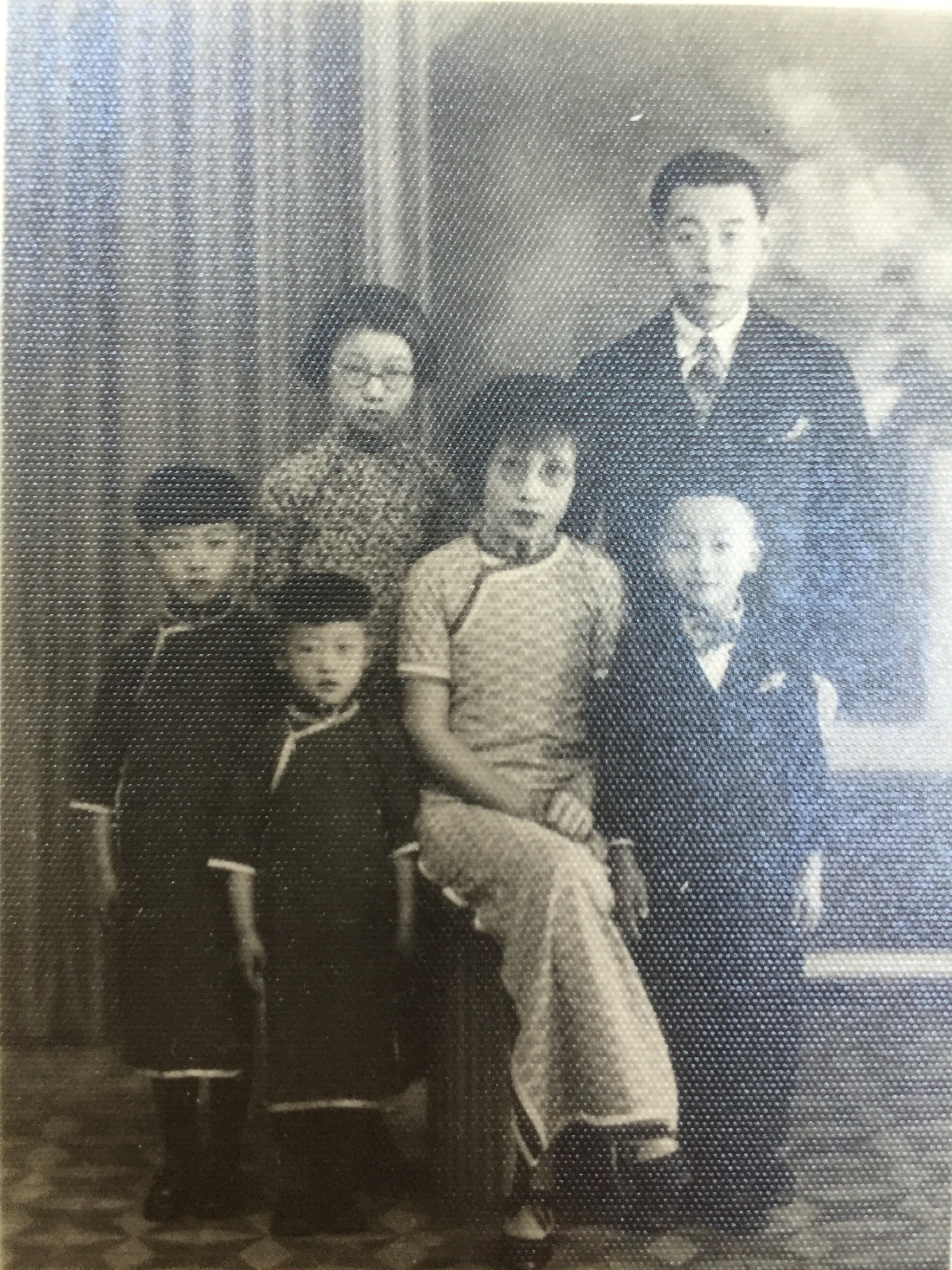1925: The First Chinese Woman Student at MIT
Li Fu lee 李勵紱
"Technology's most interesting student this year"
Li Fu Lee (Class of 1929, Electrical Engineering) was the first woman from China to attend MIT. A Han Chinese, Lee married the scion of a prominent Manchu family, Kuan Tung (Class of 1927, Electrical Engineering). Unlike the majority of Chinese students at MIT at the time, both hailed from the north: Lee was born in Changdong, Hebei province in 1904 and Kuan in Zhangbei (Changpei), Hebei province in 1902. The couple came to the US in September 1925, shortly after their wedding and honeymoon, sailing aboard the President McKinley from Shanghai to Seattle. Before coming to MIT, Lee had received a Bachelor of Science degree from the National Technical School of China. Lee's arrival at MIT in 1925 caused such a sensation that it was reported in the Boston newspapers, as noted in the Chinese Students’ Monthly:
Lee and Kuan, ca. 1925, before coming to MIT. Image courtesy Ami Kuan Danoff.
"Pretty little Lee Li Fu has registered for electrical engineering at the Massachusetts Institute of Technology and has begun a long journey on the road, that will place the little Chinese lady on equal footing with her husband * * *" Thus reported the Boston papers. Some of the news editors were so enthusiastic about this piece of unexpected news that they became very much optimistic about New China. Mrs. Tung Kuan is perhaps the first Chinese girl student studying engineering in this country that we know of. And certainly it is epoch-making that she should choose "the toughest course" in the long noted "tough" institution. It is reported that Mrs. Kuan has special interest in electrical communications, and there is ample reason to believe that future broadcasting development in China will owe much to the "fair" experts. Mrs. Kuan has entered as a junior, while her husband is doing graduate work in M. I. T. She has been recently elected by the M. I. T. Chinese Students' Club as the chairman of the social committee, and she will preside in all the subsequent socials held by that club."
Chinese Students' Monthly 21.2 (1925), p 69
In their story, "Chinese Wife at Technology Strives for Hardest Degree," the Boston Globe declared Lee "Technology's most interesting student this year." The Globe reported that Lee was considered a model student by her professors, always completing her homework on time. It further noted that this unusual student from China had "made a decided hit with the rest of the coeds at the Institute," who welcomed her warmly and made it their duty to "help the lonely girl, away from home" to get acclimated to American culture and the English language. The couple were reported living at 21 Lee St., in Cambridge, where Lee could be found in the evenings doing " her studying and the housework for her husband." Kuan, for his part, was reported to be a devoted husband, who walked her to and from class every day, carrying her satchel. The Globe concluded: "without a doubt Mrs. Tung is the most interesting coed that has ever registered as a student at Technology and she is registered in a course that is harder, so the Technology men say, than 99% of coeds ever think of taking."
Indeed, Ms. Lee's arrival at MIT was considered so noteworthy that papers across the country, from Pennsylvania to Chicago, Maryland, Ohio, Iowa and Arkansas, ran notices in the following months about this national "first," as did The Electrical Journal. In February 1926, Popular Science Monthly also ran a short piece entitled, "This Chinese Wife Smashes Many Ancient Precedents." Reading Ms. Lee's matriculation at MIT as a sign of the progress of women's rights in China, the magazine declared: "At least there is one Chinese who believes that woman should have a place outside the home as well as in." In February 1926, MIT's Technology Review re-ran the Globe picture of Lee, highlighting her as the first "Chinese Co-ed" to enter MIT.
Between 1877 and 1931, Lee was the only Chinese woman known to have attended MIT. She was also one of only 25 women in the Class of 1929, and among the first in MIT history to receive a BS degree in Course VI (Helen Williams Hardy Blackwell, Class of 1924, was the first). Thus, Lee was a pioneer among women, not only in China, but in the US as well.
After returning to China, Lee worked as an engineer and also taught at university, while raising a family. In the wake of the communist revolution, the Kuans first fled to Taiwan, where Lee held a government position, then returned to the US.
Notes: Later, Lee Minghua (Wu) became the first woman to ever receive a PhD in Mechanical Engineering from MIT (1948). Jiaoyu zhi qiao: cong Qinghua dao Mashengligong (Bridge of Education: From Tsinghua to MIT), Hong Kong: Cosmos Point Limited, 2011, 239.
Sources: MIT Chinese Students Directory: For the Past Fifty Years, 1931, Chinese Students' Monthly 21.2 (1925), p 69, Technology Review, vol 28, Feb 1926, 193, Association of MIT Alumnae timeline, Bever, Marilynn Arsey. The women of M.I.T., 1871-1941 : who they were, what they achieved / by Marilynn A. Bever, MIT BS Thesis, Humanities, 1976. Personal correspondence, Ami Kuan Danoff, Feb.-March, 2017. The Electrical Journal, Volume 95 (1925), p. 693, "This Chinese Wife Smashes Many Ancient Precedents," Popular Science Monthly, February 1926, p. 56, "Chinese Wife at Technology Strives for Hardest Degree," Boston Globe, October 20, 1925, p. A2, Burlington Hawk Eye 2Friday, October 30, 1925, Burlington, Iowa, Findlay Morning Republican, November 3, 1925, Findlay, Ohio, New Castle News, October 31, 1925, New Castle, Pennsylvania, Fayetteville Daily Democrat, November 11, 1925, Fayetteville, Arkansas, Frederick News Post, November 5, 1925, Frederick, Maryland. Meg Rosenburg contributed research to this post.


